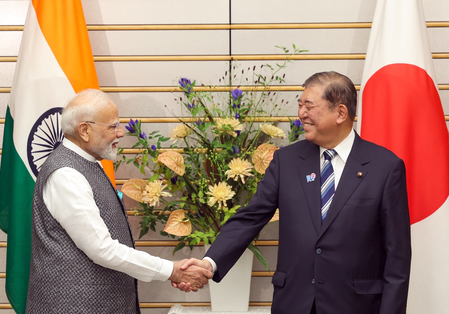Tokyo — Prime Minister Narendra Modi’s recent visit to Japan was more than just another diplomatic engagement; it was a turning point in India–Japan relations. Over the past decade, Modi has elevated the relationship from polite formalities to a strategic partnership that is shaping Asia’s political, technological, and economic landscape. The launch of the India–Japan Joint Vision for the Next Decade during this visit signals a consolidation of these efforts and outlines how Modi envisions India’s role in the emerging Asian order.
At the core of the visit was the Joint Vision, structured around eight key areas: economy, economic security, technology and innovation, green transitions, mobility, health, people-to-people ties, and state–prefecture partnerships. These are designed not as isolated projects but as integrated platforms for sustained cooperation — an approach characteristic of Modi’s governance style, which emphasizes systems, continuity, and inter-ministerial alignment.
The economic agenda took center stage. Japan pledged ¥10 trillion (about $6.8 billion annually) in public and private investment over the next decade, directed at high-speed rail, semiconductors, clean energy, and advanced technologies. More than a financial commitment, this represents Japan’s confidence in India’s growth trajectory and Modi’s reforms, aligning foreign capital with India’s national priorities of modernization, self-reliance, and technological sovereignty.
One of the boldest initiatives was the emphasis on people as a strategic resource. The Action Plan includes a two-way exchange of 500,000 professionals over five years, with 50,000 skilled Indians heading to Japan. This goes beyond cultural exchange — it addresses manpower needs in care, construction, manufacturing, and digital services. By linking training, certification, and sectoral demand, the plan operationalizes India’s demographic dividend while addressing the bottlenecks that have hindered Japanese investment in India.
Technology and innovation featured prominently. The visit showcased cooperation in semiconductors and a joint Chandrayaan-5 lunar south-pole mission, underscoring how India–Japan ties now extend into advanced science and space exploration. Modi’s engagement in Sendai highlighted India’s ambition to be not just a consumer but also a producer and hub of cutting-edge technologies.
At the India–Japan Economic Forum, Modi underscored India’s investment appeal, linking it to political stability, policy transparency, and predictability. His message — that “Japan’s excellence and India’s scale can create a perfect partnership” — positioned India as both a gateway to the Global South and a strategic partner for Japanese businesses seeking long-term growth.
Defence and security ties were also strengthened. The two nations reaffirmed joint R&D in defence electronics, naval exercises, and interoperability measures. This integration of security cooperation with technological and industrial priorities not only enhances India’s defence capabilities but also embeds them in global value chains.
On the geopolitical front, Modi reaffirmed India’s commitment to a free, open, and rules-based Indo-Pacific, aligning closely with Japan’s priorities. By synchronizing Japan’s Free and Open Indo-Pacific (FOIP) vision with India’s Indo-Pacific Oceans Initiative (IPOI), the two nations established a shared framework for regional cooperation. The accompanying security declaration emphasized practical coordination across maritime, cyber, and space domains, embedding deterrence into day-to-day operations rather than limiting it to high-level declarations.
The visit highlighted Modi’s architectural approach to diplomacy: integrated platforms, measurable targets, and state-level implementation. From ¥10 trillion in investments to 500,000 personnel exchanges, commitments were framed with timelines and deliverables. State–prefecture partnerships, in particular, address long-standing hurdles to Japanese investments by ensuring collaboration operates through local governance systems managing land, power, water, and clearances.
Ultimately, this visit is more than a milestone — it is a blueprint for India’s 21st-century diplomacy. It shows how India aligns capital with reform, embeds technology in security, translates demographics into strategy, and grounds geopolitics in practical frameworks.
In Tokyo, the partnership was defined in terms of numbers, mechanisms, and timelines — a reflection of Modi’s distinctive style of turning vision into systems and partnerships into platforms. Whether this model scales effectively over the next decade remains to be seen, but one fact is clear: Prime Minister Modi is not just managing India–Japan relations — he is architecting India’s future role in Asia.
(Sanjay Kumar Verma is a former Indian diplomat who has served as India’s High Commissioner to Canada and Ambassador to Japan and Sudan. With extensive experience in bilateral, multilateral, and regional diplomacy, he is a recognised commentator on India–Japan relations, Indo-Pacific strategy, international trade, and technology policy. Views expressed are personal.)
–IANS

